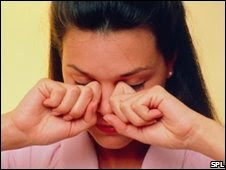 A new cure for jet lag could be on the market in the next few years after trials show a pill can reset the body's natural sleep rhythms.
A new cure for jet lag could be on the market in the next few years after trials show a pill can reset the body's natural sleep rhythms.Tasimelteon works by shifting the natural ebb and flow of the body's sleep hormone melatonin.
In trials, published in The Lancet, the drug helped troubled sleepers nod off quicker and stay asleep for longer. Experts said the drug would be a welcome alternative to addictive sedatives like benzodiazepines.
Commenting on the work, Dr Daniel Cardinali from the University of Buenos Aires said the findings would be welcomed by millions of people - "shift-workers, airline crew, tourists, football teams, and many others."
Body Clock Trickery
The hope is that if you have shifted your body clock and you've slept well, then you should perform well the next day, said lead researcher Dr Elizabeth Klerman at Brigham and Women's hospital in Boston.
In trials on 450 people who went to bed five hours earlier than normal to replicate crossing into a different time zone, those who took the drug enjoyed between 30 minutes and nearly two hours more sleep than volunteers who received a dummy pill.
Top Tips for avoiding Jet Lag
- Top up on sleep before you travel
- Shift your watch to your destination time zone as soon as you board the plane
- Avoid alcohol
- Spend plenty of time outdoors in the daylight
Natural melatonin - the darkness hormone which peaks at night - is a popular treatment for patients with body clock-related sleep disorders.
But the researchers say the potency, purity, and safety of melatonin pills is unregulated. Also, there are mixed results about whether they work in shift-workers and people with jet lag.
The US team says more work is now needed to check that their drug, which works on the same receptors in the body as melatonin, actually improves daytime performance and alertness without any carryover sedative effect.
Don't Eat?
A new discovery of a "mealtime clock" in our brains suggests that a short fast from eating could allow people to cope with jet lag and nightshift grogginess.
This food-related clock, which was found in mice, is similar to our body's primary timekeeper called the circadian rhythm, so scientists think the finding could apply to humans.
While the light-driven circadian rhythm is in charge most of the time, the researchers suggest in the May 23 issue of the journal Science that the mealtime clock takes over when food is scarce. By changing animals' behavior patterns so they don't snooze through an opportunity to eat, this newly discovered clock may be crucial to survival. And it could also ward off jet lag in humans.
Clifford Saper of Harvard's Beth Israel Deaconess Medical Center and his colleagues discovered the food clock by running experiments in mice that were missing a key biological clock gene. The team restored the gene's function in one part of the brain at a time to see which cells responded to food.
"We discovered that a single cycle of starvation followed by refeeding turns on the clock," Saper said, "so that it effectively overrides the suprachiasmatic nucleus [the circadian clock] and hijacks all of the circadian rhythms onto a new time zone that corresponds with food availability."
In addition to keeping animals' bellies plenty full, the clock has implications for travelers and shift workers.
For example, if you travel from the United States to Japan, your body needs to adjust to a 13-to-16-hour time difference. "Because the body's biological clock can only shift a small amount each day, it takes the average person about a week to adjust to the new time zone," Saper said. "And, by then, it's often time to turn around and come home."
By changing your eating schedules, a traveler might be able to rev up this secondary clock and adjust more quickly to the new time zone.
"A period of fasting with no food at all for about 16 hours is enough to engage this new clock," Saper said. "So, in this case, simply avoiding any food on the plane, and then eating as soon as you land, should help you to adjust."
The research was supported by grants from the U.S. Public Health Service.













0 comments:
Post a Comment